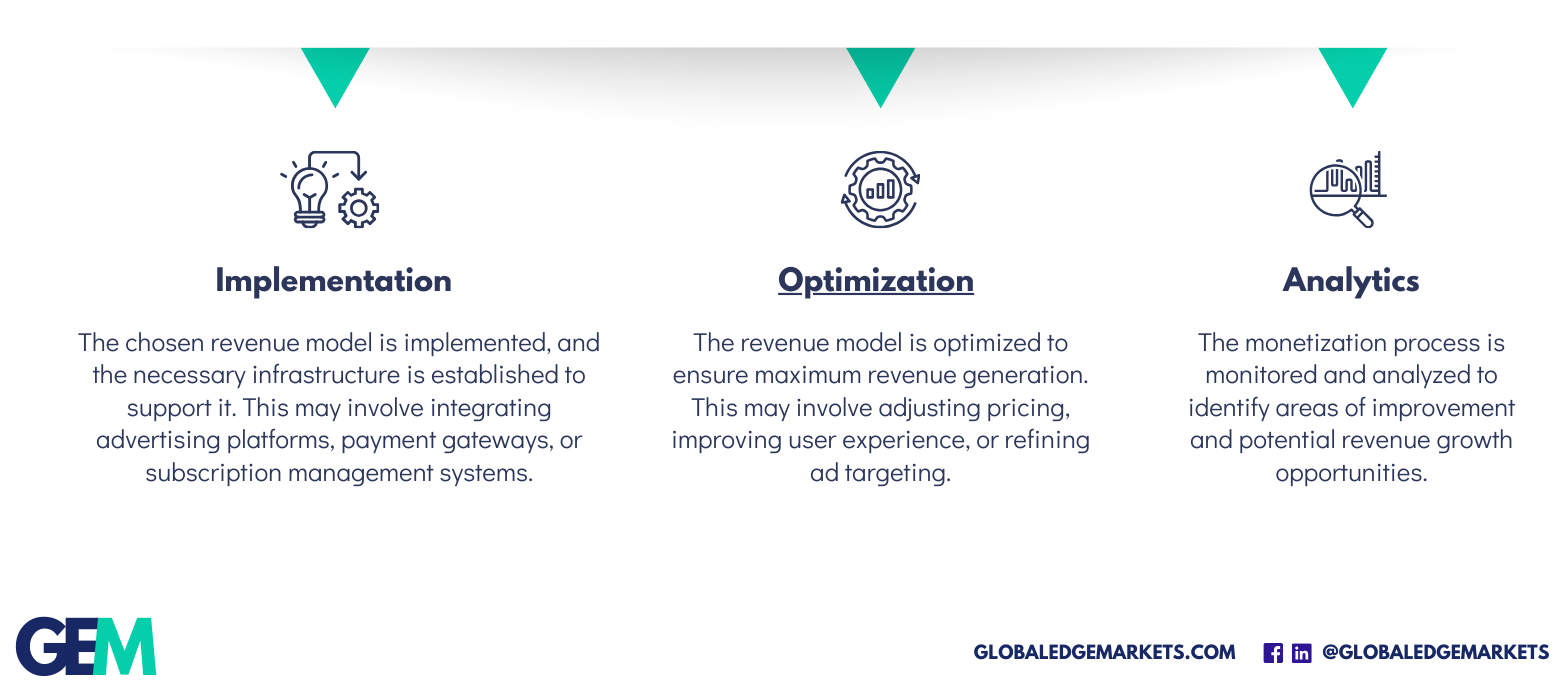Productization And Monetization
about the service
Maximizing Revenue
Productization and Monetization both share the common goal of increasing revenue and profitability for a business. They both involve turning a product or service into a profitable and sustainable revenue stream. Productization involves creating a standardized, scalable, and replicable product offering while monetization involves finding the best ways to generate income from that product. Both processes require market research, strategic planning, and execution in order to be successful.
The Monetization Process
The monetization process begins with identifying the product, service, or content that has the potential to generate revenue. The next step is determining the revenue model that best suits the business and its customers.
- Finding the Right Monetization Model for Your Product
With so many monetization models available, finding the right one for your product can be challenging. Below, we will explore the key considerations when choosing a monetization model and provide examples of popular models to help you make an informed decision.
- Know Your Customer Base
Before choosing a monetization model, it is essential to understand your customer base. You need to identify your target market, their needs, and what they are willing to pay for your product or service. Market research and analyzing customer behavior can help you determine the best way to monetize your product.
- Consider the Product's Value Proposition
Your product’s value proposition is what sets it apart from the competition. Understanding what makes your product unique and how it solves your customer’s problems is essential. Understanding your product’s value proposition will help you determine the best monetization model.
- Evaluate Your Competition
Analyzing your competition and understanding how they are monetizing their products is essential. It will help you identify gaps in the market and determine the best way to position your product in the market. Understanding your competition can also help you identify potential pitfalls and avoid making the same mistakes.
- Explore Monetization Models
After conducting market research, analyzing customer behavior, understanding your product’s value proposition, and evaluating your competition, it’s time to explore monetization models.
Featured service
Our Digital Transformation Assessment helps you evaluate where your business stands today on its digital transformation journey and what areas to invest in going forward.
Test & Iterate
Once you’ve chosen a monetization model (or mix of models), testing it and iterating based on customer feedback is essential. It’s crucial to be flexible and adapt as necessary to ensure the long-term success of your product. Collecting customer feedback and making necessary changes can help you create a product that meets your customer’s needs while generating sustainable revenue.
Once the revenue model has been chosen, the monetization process involves the following stages:

Research on Productization & Monetization and Using a Consultant
Statistics suggest that productization and monetization are becoming increasingly important for companies that want to achieve growth and profitability. According to a study conducted by McKinsey & Company, companies that focus on productization and monetization have an impressive 3.5 times higher revenue growth rate than their peers.
And a survey of 1,000 businesses by PwC showed that 60% planned to invest in productization and monetization in the next 12-18 months. These companies know that focusing on productization and monetization can bring higher revenue growth, improved profit margins, and more tremendous success in new product development.
More Research:
- A study by the Harvard Business Review found that companies that monetize their data have 5-7% higher profit margins than those that do not.
- In a survey of 300 executives by Accenture, 87% of respondents said productization was important to their business growth strategy.
- A study by the Product Development and Management Association found that companies that prioritize productization have a 60% higher success rate for new product development.
- According to a survey by Gartner, companies that successfully monetize their data generate 33% more revenue than those that do not.
- In a survey of 750 B2B marketers by SiriusDecisions, 92% of respondents said their companies were shifting towards a productization model.
- According to a report by Accenture, companies that successfully monetize their digital services achieve a 15-20% higher EBITDA margin than those that do not.
some stats
why monetize?
- Digital strategies depend on short-term, month-to-month product roadmaps, digital marketing campaigns, and other activities tied to actionable items and measurable business objectives, such as online sales, conversions, and customer-based metrics (LTV or referrals as an example), and other factors.
- To be successful, the strategy should focus on where the company value chain is vulnerable to disruption or crisis and could be optimized for a digital reboot. One of the challenges of establishing a digital strategy is determining which services should be done in-house, which services should be outsourced or co-sourced with a third-party provider, and which services require customization or productization to be viable and beneficial.
- Sometimes, a free or public asset is turned into a profit center—such as a public road being converted into a private tollway. This is a very crude or straightforward method of monetization, but when it comes to more complex business models, new techniques and ideas are needed to innovate ways to bring value to the consumer of a B2B client while financially justifying the service product or capability.
Boosting Profits in the Cloud
The revenue projection for the SaaS (Software as a Service) industry by 2025 is estimated to reach approximately $223 billion. This is a significant increase from the revenue projection for 2020, which was estimated to reach $143 billion.
The SaaS industry has seen tremendous growth in recent years due to the increasing demand for cloud-based solutions and the shift towards remote work caused by the COVID-19 pandemic. As a result, the SaaS industry is expected to continue its rapid growth in the coming years, with many companies investing in cloud-based solutions to streamline their operations and increase efficiency.
The ARPU (Average Revenue Per User) of freemium apps varies greatly depending on the type of app, target market, and monetization strategy. It can also change from year to year.
The ARPU of freemium apps in 2023 is expected to continue to increase as more businesses adopt the freemium model and as more users become comfortable with making in-app purchases. The COVID-19 pandemic has also accelerated the shift towards digital services, which is expected to further drive the growth of the freemium model and the ARPU.
from our blog
Related Posts

The Key to Productization for Mid-Sized Companies
Productization is the process of transforming a service-based company into a product-based one. This can be a powerful strategy for middle-sized companies that want to

Transforming Startups from Free to Fee: Effective Monetization and Productization Strategies
The life cycle of a startup is often marked by rapid growth and development, with strategic business management playing a pivotal role. In particular, transitioning from offering free to fee-based products or services is a crucial phase in a startup’s journey. This step symbolizes a significant shift in business strategy, representing a move towards profitability and long-term sustainability. However, the transformation process is not without challenges. It requires a nuanced approach to ensure that customer relationships, product value, and the overarching business reputation remain intact. As startups move forward with their business expansion plans, they must balance attracting new users and retaining existing ones. This in-depth guide provides the groundwork for startups seeking to transition from free to fee, with the objective of achieving sustainable business growth.

The Power of Subscription Models: Embracing Recurring Revenue in Startups
Dive deep into the transformative power of subscription models in startups. Discover how embracing recurring revenue paves the way for strategic growth in GlobalEdgeMarkets.



